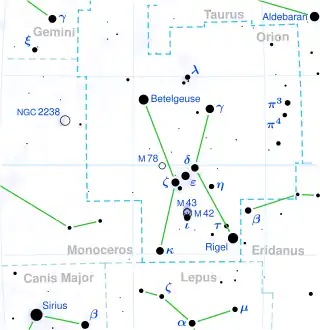| Observation data Epoch J2000.0 Equinox J2000.0 | |
|---|---|
| Constellation | Orion |
| Right ascension | 06h 00m 03.50386s[1] |
| Declination | +02° 42′ 23.5968″[1] |
| Apparent magnitude (V) | +11.307[2] |
| Characteristics | |
| Spectral type | M3.5Ve[3] or dM4.0[4] |
| B−V color index | 1.667[2] |
| Astrometry | |
| Radial velocity (Rv) | +30.228±0.0038[5] km/s |
| Proper motion (μ) | RA: +309.487[1] mas/yr Dec.: −40.640[1] mas/yr |
| Parallax (π) | 192.0135 ± 0.0310 mas[6] |
| Distance | 16.986 ± 0.003 ly (5.2080 ± 0.0008 pc) |
| Absolute magnitude (MV) | +12.71[3] |
| Details[4] | |
| Mass | 0.2312±0.0058 M☉ |
| Radius | 0.2457±0.0078 R☉ |
| Luminosity | 0.006329±0.000088 L☉ |
| Luminosity (bolometric) | 0.0086[7] L☉ |
| Surface gravity (log g) | 5.10±0.07 cgs |
| Temperature | 3,284±51 K |
| Metallicity [Fe/H] | −0.12±0.16 dex |
| Rotation | 1.809 d[8] |
| Rotational velocity (v sin i) | 5.8±0.3 km/s[3] km/s |
| Other designations | |
| Database references | |
| SIMBAD | data |
 GJ 3379 Location of GJ 3379 in the constellation Orion | |
GJ 3379 (Giclas 99-49) is the nearest star in the Orion constellation, located at a distance of 17 light years from the Sun based on parallax. It is a single star[3] with an apparent visual magnitude of +11.31[2] and an absolute magnitude of +12.71,[3] therefore, the star is not visible with the naked eye. It is positioned in the upper left part of the Orion constellation, to the SSE of Betelgeuse. This star is drifting further away with a radial velocity of +30.0 kilometers per second.[5] In the past, this star had a relatively close encounter with the Solar System. Some 161,000±6,000 years ago, it achieved a minimum distance of 4.08 ± 0.20 ly (1.25 ± 0.06 pc).[10]
Physical characteristics
This star is a small red dwarf with a stellar classification of M3.5V[3] – an M-type main-sequence star. It is much smaller, cooler, and less massive than the Sun, radiating only 0.6% of the Sun's luminosity.[4] This is a very active[11] star that varies in brightness with an amplitude of 0.0074±0.0029 magnitude, modulated by a rapid rotation period of 1.8 days.[8] The magnetic field strength has been measured as 2.3 kG. It is a source of X-ray emission with a luminosity of 9.5×1027 erg s−1.[12]
According to the SIMBAD database, the star is classified as an eruptive variable.[9]
References
- 1 2 3 4 Brown, A. G. A.; et al. (Gaia collaboration) (August 2018). "Gaia Data Release 2: Summary of the contents and survey properties". Astronomy & Astrophysics. 616. A1. arXiv:1804.09365. Bibcode:2018A&A...616A...1G. doi:10.1051/0004-6361/201833051. Gaia DR2 record for this source at VizieR.
- 1 2 3 Zacharias, N.; et al. (2012). "The fourth US Naval Observatory CCD Astrograph Catalog (UCAC4)". VizieR On-line Data Catalog. 1322. Bibcode:2012yCat.1322....0Z.
- 1 2 3 4 5 6 Davison, Cassy L.; et al. (March 2015). "A 3D Search for Companions to 12 Nearby M-Dwarfs". The Astronomical Journal. 149 (3): 106. arXiv:1501.05012. Bibcode:2015AJ....149..106D. doi:10.1088/0004-6256/149/3/106. S2CID 9719725.
- 1 2 3 Schweitzer, A.; et al. (May 2019). "The CARMENES search for exoplanets around M dwarfs. Different roads to radii and masses of the target stars". Astronomy & Astrophysics. 625: 16. arXiv:1904.03231. Bibcode:2019A&A...625A..68S. doi:10.1051/0004-6361/201834965. S2CID 102351979. A68.
- 1 2 Soubiran, C.; et al. (2018). "Gaia Data Release 2. The catalogue of radial velocity standard stars". Astronomy and Astrophysics. 616: A7. arXiv:1804.09370. Bibcode:2018A&A...616A...7S. doi:10.1051/0004-6361/201832795. S2CID 52952408.
- ↑ Brown, A. G. A.; et al. (Gaia collaboration) (2021). "Gaia Early Data Release 3: Summary of the contents and survey properties". Astronomy & Astrophysics. 649: A1. arXiv:2012.01533. Bibcode:2021A&A...649A...1G. doi:10.1051/0004-6361/202039657. S2CID 227254300. (Erratum: doi:10.1051/0004-6361/202039657e). Gaia EDR3 record for this source at VizieR.
- ↑ Khata, Dhrimadri; et al. (April 2020). "Understanding the physical properties of young M dwarfs: NIR spectroscopic studies". Monthly Notices of the Royal Astronomical Society. 493 (3): 4533–4550. arXiv:2002.05762. Bibcode:2020MNRAS.493.4533K. doi:10.1093/mnras/staa427.
- 1 2 Newton, Elisabeth R.; et al. (April 2016). "The Rotation and Galactic Kinematics of Mid M Dwarfs in the Solar Neighborhood". The Astrophysical Journal. 821 (2): 21. arXiv:1511.00957. Bibcode:2016ApJ...821...93N. doi:10.3847/0004-637X/821/2/93. S2CID 89615849. 93.
- 1 2 "G 99-49". SIMBAD. Centre de données astronomiques de Strasbourg. Retrieved 18 August 2017.
- ↑ Bobylev, V. V. (2017). "Search for close stellar encounters with the solar system from data on nearby dwarfs". Astronomy Reports. 61 (10): 883–890. arXiv:1708.03300. Bibcode:2017ARep...61..883B. doi:10.1134/S106377291710002X. ISSN 1063-7729. S2CID 119424830.
- ↑ Zechmeister, M.; et al. (January 2018). "Spectrum radial velocity analyser (SERVAL). High-precision radial velocities and two alternative spectral indicators". Astronomy & Astrophysics. 609: 13. arXiv:1710.10114. Bibcode:2018A&A...609A..12Z. doi:10.1051/0004-6361/201731483. S2CID 59449762. A12.
- ↑ Feiden, Gregory A.; Chaboyer, Brian (December 2013). "Magnetic Inhibition of Convection and the Fundamental Properties of Low-mass Stars. I. Stars with a Radiative Core". The Astrophysical Journal. 779 (2): 25. arXiv:1309.0033. Bibcode:2013ApJ...779..183F. doi:10.1088/0004-637X/779/2/183. S2CID 118558471. 183.
External links
- "The 100 nearest star systems". Research Consortium On Nearby Stars. Retrieved 2020-12-26.